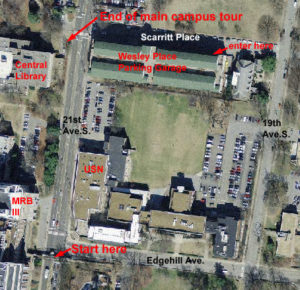Main Campus Tree Tour
About the tour
The Vanderbilt main campus tree tour is focused primarily on trees that are native to Middle Tennessee or naturalized, although a few other interesting non-native trees are included. It is a loop that goes from Wesley Place garage on the east side of campus to the west side of campus near the Memorial Gym and back.
How the tour works
The tour is designed to make use of portable devices. An iPad is optimal, although smart phones should also work well. Each tree has its own web page and is connected to the previous and next tree by buttons at the top of the page. In addition to the text description of the tree’s location, there is a map at the bottom of the page showing where the tree is located relative to landmarks on the campus.
If your phone or iPad has GPS, you can use the “Find Me!”
button on the page to locate the tree. When you click on the button, a drop pin will fall on the tree’s location on a map.
If you then click on the button to display your location on the map, you can see where you are relative to tree. You should be able to zoom in and make your “blue dot” meet the drop pin as you walk towards the tree. (Because the campus WiFi network covers many outdoor areas, you may be able to take parts of the tour without 3G. However, early version WiFi-only iPads do not have GPS capabilities. The Find Me! button will bring up a map with drop pin, but will not show your location.)
Each tree page also has a QR code that you can scan to load the tree’s page into your phone. If a tree on the tour has a physical label, there will be a QR code sticker on the label as
well. This is one way to know that you have located the right tree. It also allows anyone who discovers the QR code to load the tree’s web page into their portable device.
Where to park
Parking on the Vanderbilt Campus can be challenging because there are few designated visitor spaces. The Visitor Parking page contains information about possible places to park, but for this tour it is recommended that you park in the Wesley Place parking garage because it is near the start of the tour and contains many pay-by-the-hour parking spaces that can be utilized by visitors. There is free parking on the north side of Scarritt Place opposite the garage, but it is for a limited time and is usually filled by mid-morning on weekdays. Do not park in reserved or zone parking without a permit. You will be ticketed and possibly towed.

Starting the tour
The tour starts on the bridge between Peabody and Main Campus over 21st Avenue. From the Wesley Place garage, go west to 21st Ave.S. then turn left and walk along the street past the University School (USN). When you reach Edgehill Avenue, cross the street,
then turn left to enter the pedestrian bridge. To start the tour at the beginning, click on the “Begin” button above.
You can also start from any other location by clicking on one of the
tree points on the tree tour map, then clicking on the link in the resulting bubble. Not all 60+ trees are displayed at the initial zoom level, so use the + button on the map to see more detail.
A third option is to pick a tree from the list below. The tree’s page has a map showing its location.
List of trees on the tour:
Note: since the tour was created, some trees have died or been cut down. These trees are indicated by “R.I.P”. You can still view their page, but you won’t be able to see the actual tree any more.
1: pin oak 1-483
2: bald cypress 4-942
3: southern red oak 2-123
4: white ash 4-1245
5: holly 2-560
6: white basswood (no ID) R.I.P.
7: redbud 2-424 R.I.P.
8: black walnut 2-502
9: shingle oak 2-437
10: bald cypress 4-1089
11: tulip tree 2-260
12: bitternut hickory 4-1047
13: chinkapin oak 3-140
14: black walnut 3-119
15: tree of heaven 3-192 R.I.P.
16: red maple 2-336
17: Osage orange 2-250
18: northern red oak 2-351 R.I.P.
19: bur oak 2-691 “bicentennial oak” R.I.P.
20: black oak 2-854
21: September elm 2-528 R.I.P.
22: eastern redcedar 2-856
23: American elm 2-674
24: river birch 3-300
25: Shumard oak 3-196 “Big Al”
26: hophornbeam 3-771
27: sycamore 3-52
28: white pine 3-210
29: sweetgum 4-274
30: persimmon 4-733
31: princess tree 4-1022
32: box elder 3-178
33: American elm 3-589 R.I.P.
34: sugar maple 3-366
35: silver maple 3-722
36: cottonwood 3-62
37: red mulberry 3-388
38: green ash 3-87 R.I.P.
39: swamp chestnut oak 3-250 R.I.P.
40: mockernut hickory 2-568 R.I.P.
41: sweetbay magnolia 2-70
42: Chinese magnolia 2-345
43: cucumber magnolia 2-558
44: tulip tree 2-780
45: pawpaw 2-946
46: ginkgo 2-1014 R.I.P.
47: northern hackberry 2-253
48: sugarberry 2-285
49: bush honeysuckle (no ID) R.I.P.
50: bigleaf magnolia 2-242 R.I.P.
51: black gum 2-511 R.I.P.
52: black gum 2-1025 R.I.P.
53: bur oak 2-412
54: white oak 2-304
55: dogwood 2-539
56: southern magnolia 2-247
57: hemlock 2-978
58: dawn redwood 2-985
59: American hornbeam 2-950
60: beech 2-194
61: sassafras 2-993 R.I.P.
62: willow oak 2-795
63: northern catalpa 2-930
